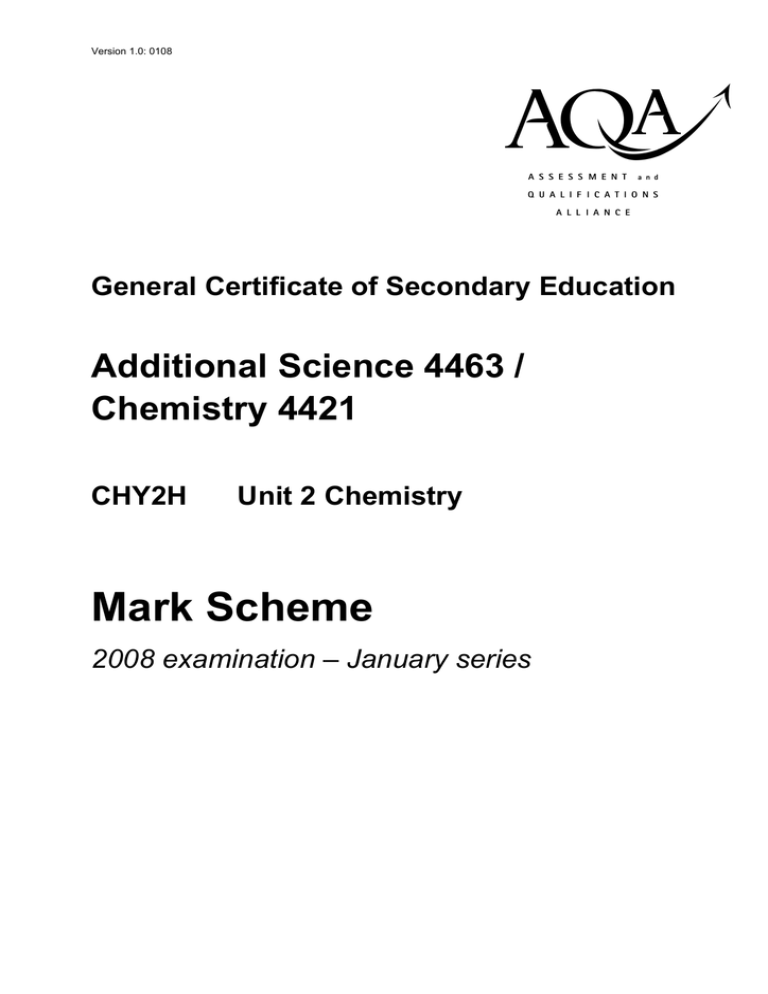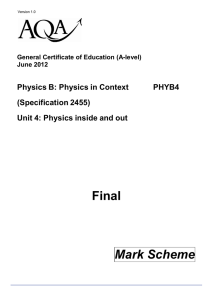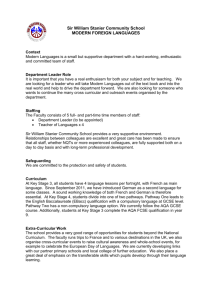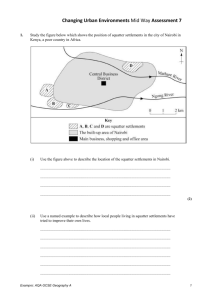
Version 1.0: 0108
abc
General Certificate of Secondary Education
Additional Science 4463 /
Chemistry 4421
CHY2H
Unit 2 Chemistry
Mark Scheme
2008 examination – January series
Mark schemes are prepared by the Principal Examiner and considered, together with the
relevant questions, by a panel of subject teachers. This mark scheme includes any
amendments made at the standardisation meeting attended by all examiners and is the scheme
which was used by them in this examination. The standardisation meeting ensures that the
mark scheme covers the candidates’ responses to questions and that every examiner
understands and applies it in the same correct way. As preparation for the standardisation
meeting each examiner analyses a number of candidates’ scripts: alternative answers not
already covered by the mark scheme are discussed at the meeting and legislated for. If, after
this meeting, examiners encounter unusual answers which have not been discussed at the
meeting they are required to refer these to the Principal Examiner.
It must be stressed that a mark scheme is a working document, in many cases further
developed and expanded on the basis of candidates’ reactions to a particular paper.
Assumptions about future mark schemes on the basis of one year’s document should be
avoided; whilst the guiding principles of assessment remain constant, details will change,
depending on the content of a particular examination paper.
Further copies of this Mark Scheme are available to download from the AQA Website: www.aqa.org.uk
Copyright © 2008 AQA and its licensors. All rights reserved.
COPYRIGHT
AQA retains the copyright on all its publications. However, registered centres for AQA are permitted to copy material
from this booklet for their own internal use, with the following important exception: AQA cannot give permission to
centres to photocopy any material that is acknowledged to a third party even for internal use within the centre.
Set and published by the Assessment and Qualifications Alliance.
The Assessment and Qualifications Alliance (AQA) is a company limited by guarantee registered in England and Wales (company number 3644723) and a registered charity (registered charity number 1073334).
Registered address: AQA, Devas Street, Manchester M15 6EX
Dr Michael Cresswell Director General
Additional Science / Chemistry CHY2H – AQA GCSE Mark Scheme 2008 January Series
MARK SCHEME
Information to Examiners
1.
General
The mark scheme for each question shows:
•
•
•
•
the marks available for each part of the question
the total marks available for the question
the typical answer or answers which are expected
extra information to help the Examiner make his or her judgement and help to
delineate what is acceptable or not worthy of credit or, in discursive answers, to give
an overview of the area in which a mark or marks may be awarded.
The extra information is aligned to the appropriate answer in the left-hand part of the
mark scheme and should only be applied to that item in the mark scheme.
At the beginning of a part of a question a reminder may be given, for example:
where consequential marking needs to be considered in a calculation;
or the answer may be on the diagram or at a different place on the script.
In general the right hand side of the mark scheme is there to provide those extra details
which confuse the main part of the mark scheme yet may be helpful in ensuring that
marking is straightforward and consistent.
2.
3.
Emboldening
2.1
In a list of acceptable answers where more than one mark is available ‘any two
from’ is used, with the number of marks emboldened. Each of the following lines
is a potential mark.
2.2
A bold and is used to indicate that both parts of the answer are required to award
the mark.
2.3
Alternative answers acceptable for a mark are indicated by the use of or.
(Different terms in the mark scheme are shown by a / ; eg allow smooth / free
movement.)
Marking points
3.1
Marking of lists
This applies to questions requiring a set number of responses, but for which
candidates have provided extra responses. The general principle to be followed
in such a situation is that ‘right + wrong = wrong’.
Each error/contradiction negates each correct response. So, if the number of
error/contradictions equals or exceeds the number of marks available for the
question, no marks can be awarded.
However, responses considered to be neutral (indicated as * in example 1) are
not penalised.
3
Additional Science / Chemistry CHY2H – AQA GCSE Mark Scheme 2008 January Series
Example 1: What is the pH of an acidic solution? (1 mark)
Candidate
Response
1
2
3
4
4,8
green, 5
red*, 5
red*, 8
Marks
awarded
0
0
1
0
Example 2: Name two planets in the solar system. (2 marks)
Candidate
1
2
3.2
Response
Pluto, Mars, Moon
Pluto, Sun, Mars,
Moon
Marks awarded
1
0
Use of chemical symbols / formulae
If a candidate writes a chemical symbol / formula instead of a required chemical
name, full credit can be given if the symbol / formula is correct and if, in the
context of the question, such action is appropriate.
3.3
Marking procedure for calculations
Full marks can be given for a correct numerical answer, as shown in the column
‘answers’, without any working shown.
However if the answer is incorrect, mark(s) can be gained by correct
substitution / working and this is shown in the ‘extra information’ column;
3.4
Interpretation of ‘it’
Answers using the word ‘it’ should be given credit only if it is clear that the ‘it’
refers to the correct subject.
3.5
Errors carried forward
Any error in the answers to a structured question should be penalised once only.
Papers should be constructed in such a way that the number of times errors can
be carried forward are kept to a minimum. Allowances for errors carried forward
are most likely to be restricted to calculation questions and should be shown by
the abbreviation e.c.f. in the marking scheme.
3.6
Phonetic spelling
The phonetic spelling of correct scientific terminology should be credited unless
there is a possible confusion with another technical term.
3.7
Brackets
(…..) are used to indicate information which is not essential for the mark to be
awarded but is included to help the examiner identify the sense of the answer
required.
3.8
Unexpected Correct Answers not in the Mark Scheme
The Examiner should use professional judgement to award credit where a
candidate has given an unexpected correct answer which is not covered by the
mark scheme. The Examiner should consult with the Team Leader to confirm
the judgement. The Team Leader should pass this answer on to the Principal
Examiner with a view to informing all examiners.
4
Additional Science / Chemistry CHY2H – AQA GCSE Mark Scheme 2008 January Series
CHY2H
Question 1
question
(a)
answers
extra information
sensible line of best fit which goes
through or close to all the points except
the anomalous point
allow wobbly / short double lines
(b)
loss of gas / loss of CO2
idea of gas produced / formed
(c)
7
(d)(i)
mark
1
± ½ square
1
1
steeper line from around the same starting
point and left of the points
allow crosses if they are fully correct
for 1 mark
1
levelling off at 99
accept short level line at 99
1
± ½ square
(d)(ii)
3
any three from:
• particles / molecules / atoms/ ions
have more energy
allow given / gain / get energy
• move faster
ignore move about more
ignore vibrate more / faster
ignore collide quicker / faster
• collide more often
or more chance of collisions
or bump into each other more
• collide with more force / energy
or more particles have the activation
energy
or more collisions result in reaction
or more collisions are successful
8
total
5
Additional Science / Chemistry CHY2H – AQA GCSE Mark Scheme 2008 January Series
CHY2H
Question 2
question
(a)
answers
extra information
any one from:
mark
1
• they are made of layers
do not accept line / rows / lattice
• atoms / ions / particles / layers (of
atoms) can slide over each other
(b)
1
any one from:
• smaller / tiny or very small
do not allow small alone
• correct size range 1 to 100 nanometres
• a few hundred atoms in size
(c)
if they state smaller and give a size
outside range ignore size if it is less
than 20,000
harder
1
plus one from:
1
• so does not wear as quickly / erode as
quickly
• less vulnerable to damage owtte
ignore corrode
harder to wear down = 1 mark
• because they have a high surface area
to volume ratio
or
stronger
(1)
plus one from:
(1)
• less likely to break / do not break
accept withstand pressure
• not as vulnerable to damage owtte
harder and stronger alone gains 1
mark
• do not bend out of shape
• because they have a high surface area
to volume ratio
total
4
6
Additional Science / Chemistry CHY2H – AQA GCSE Mark Scheme 2008 January Series
CHY2H
Question 3
question
answers
(a)
N2O
(b)
13.8 to 14
extra information
mark
1
gains full marks without working
2
if answer incorrect
13 gains 1 mark
or
14/101 × 100 gains 1 mark
total
3
7
Additional Science / Chemistry CHY2H – AQA GCSE Mark Scheme 2008 January Series
CHY2H
Question 4
question
(a)
answers
extra information
mark
electric current / electricity
1
plus one from:
1
•
is passed through ionic compound /
substance / electrolyte
must be linked to electricity
•
passed through molten/aqueous
compound / substance
do not allow solution / liquid alone
•
causing decomposition
accept split up / breakdown /
breaking up owtte
allow liquid compound / substance
ignore separated
accept elements are formed
ignore new substances form
(b)
hydrogen
1
accept H2
2
do not accept H / H
(c)
one electron from each atom
accept each carbon is bonded to three
other carbon atoms leaving one
(unbonded) electron owtte
1
is delocalised / free (to move)
must be linked to electrons
1
answers of delocalised / free
electrons only, gains 1 mark
accept each carbon is bonded to three
other carbon atoms leaving
delocalised / free electrons
= 2 marks
maximum 1 mark if graphite
described as a metal / giant ionic
lattice
total
5
8
Additional Science / Chemistry CHY2H – AQA GCSE Mark Scheme 2008 January Series
CHY2H
Question 5
question
(a)
answers
extra information
mark
any one from:
1
• gives out heat / energy
accept releases / gives off owtte
• transfers energy from a substance to
the surroundings
ignore references to light
• ΔH / energy change / enthalpy change
is negative
(b)
2Mg
+
O2
→
2MgO
(c)
accept correct multiples / fractions
1
electrons do not need to be paired
1
accept dots / circles / e instead of
crosses
do not allow 2.6 without diagram
(d)
electrons do not need to be paired
1
allow without brackets
must have the charge
accept dots / circles / e instead of
crosses
ignore extra empty outer shells
ignore nucleus
do not allow [2.8]2+without diagram
continued…
9
Additional Science / Chemistry CHY2H – AQA GCSE Mark Scheme 2008 January Series
CHY2H
Question 5 continued…
question
(e)
answers
extra information
mark
oppositely charged (ions / atoms)
allow positive and negative(ions /
atoms)
1
(they) attract
must be in correct context
1
accept held by electrostatic forces
ignore ionic bonding
maximum 1 if they refer to
intermolecular forces / attractions /
covalent bonds
(f)
magnesium chloride
accept MgCl2 (if correctly written)
total
1
7
10
Additional Science / Chemistry CHY2H – AQA GCSE Mark Scheme 2008 January Series
CHY2H
Question 6
question
(a)
answers
extra information
Compound A
any one from:
accept correct formulae
•
sodium bromide
•
potassium bromide
•
ammonium bromide
•
hydrogen bromide
•
any metal bromide except silver and
lead.
1
1
Compound B
(b)
mark
silver nitrate
accept silver sulfate
the silver compound will decompose /
silver ions be reduced to silver (owtte)
accept film would darken owtte
1
accept any idea of light changing
silver bromide / silver ions / silver
nitrate / silver sulfate
allow ‘forms a black solid’ / it would
turn black
(c)
precipitation
accept descriptions of precipitation
reactions
1
accept double decomposition
accept precipitate
do not allow displacement
(d)
1
electrons
are gained
the second mark must be linked to
electrons
1
accept it / silver / silver ions gains
electrons for both marks
ignore references to oxygen
total
6
11
Additional Science / Chemistry CHY2H – AQA GCSE Mark Scheme 2008 January Series
CHY2H
Question 7
question
(a)
answers
extra information
mark
gains 3 marks without working
1213.8 to 1214.3
3
correct answer not given then check
working
1 mark for each correct step
1000
28
= 35.7 mol
1) moles of N2 =
do not penalise rounding errors in
this part
2) moles of NH3 = 2 × (answer from (1))
= 71.4 mol
3) mass of NH3 = (answer from 2) × 17
= 71.4 × 17 = 1214 g
or
•
28g of N2
→
•
1g of N2
→
•
1000 g of N2 →
34g of NH3
1 mark for each correct step
34
28
= 1.214g NH3
do not penalise rounding errors in
this part
allow error carried forward eg
1000 × 1.214
= 1214g
or
•
1000 ×
34
28
gains 2 marks if correct answer not
given
28
gains 1 mark, 2 marks if
34
correctly calculated (823.5g)
28
gains 1 mark if
1000 ×
17
calculated correctly (1647.05g)
1000 ×
or
other correct methods
look for the key ideas in the methods
above
continued…
12
Additional Science / Chemistry CHY2H – AQA GCSE Mark Scheme 2008 January Series
CHY2H
Question 7 continued…
question
(b)
answers
extra information
mark
gains 2 marks even when there is no
working
25 / 25.035 or ecf from (a)
2
incorrect answer then
304/(their answer from (a)) × 100
gains 1 mark
or using figures from part (b)
gains 2 marks even when there is no
working
accept 27 for 1 mark
27.6 / 28
if answers incorrect then304/1100 ×
100 gains 1 mark
(c)(i)
increase yield
1
reaction is exothermic
1
or
allow decreased yield because rate of
reaction is slower / fewer collisions for 2
marks
(c)(ii)
must get both points for 2 marks
increase yield
1
plus one from:
1
• more (gaseous) reactant molecules
than (gaseous) product molecules
(owtte)
accept greater volume on the left than
the right owtte
• increased rate of reaction / more
collisions
continued…
13
Additional Science / Chemistry CHY2H – AQA GCSE Mark Scheme 2008 January Series
CHY2H
Question 7 continued…
question
(d)
answers
extra information
any one from:
mark
1
economic
•
large town provides workforce
•
workers do not have to travel far to
the factory. (owtte)
•
transport infrastructure already in
place for large town. (owtte)
•
factory brings prosperity to town
(owtte)
•
factory provides employment
•
reduced tourism
•
reduction in local house prices
•
any other sensible economic factor
linked to town
any one from:
1
safety
do not allow polluting gases
unqualified
•
escape of dangerous / harmful
chemicals / gases (owtte)
•
danger of increased traffic
•
risk of explosion.(owtte) /danger of
high pressure
•
consequences of an accident could be
severe if the town is close
•
any other sensible safety idea
continued…
14
Additional Science / Chemistry CHY2H – AQA GCSE Mark Scheme 2008 January Series
CHY2H
Question 7(d) continued…
question
answers
extra information
any one from:
mark
1
environmental
•
factory might be unsightly (owtte)
•
screening of factory (owtte)
•
loss of habitats (owtte)
•
plant trees/ hedges etc on and around
plant site
• pollution of water / air / soil could
harm plants / animals or noise
pollution
must be explained
• CO2 is produced by burning fuels /
heating
• CO2 causes global warming / any
effect of global warming
•
eye sore
• any other sensible environmental
factor
total
12
15







